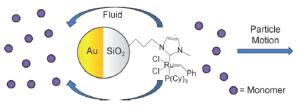 |
Polymer-powered! A polymerization reaction is used to power the first micromotor outside biological systems. The motor employs a form of Grubbs’ catalyst asymmetrically bound to gold–silica Janus microspheres. These motors show increased diffusion of up to 70?% when placed in solutions of the monomer. The motors also exhibit chemotaxis when placed in a monomer gradient.
[Credit: Angewandte Chemie International Edition] |
The motors consist of spheres that are barely a micrometer in size, made half of gold, half of silicon dioxide. Certain catalyst molecules (a Grubbs catalyst) that catalyze polymerizations can be attached to the silicon dioxide surface. Sen and his team use norbornene as a monomer. The catalyst opens the rings and strings these monomers together into long chain molecules.
As soon as the reaction begins, the spheres start driving through the surrounding liquid. How is it that such a reaction can cause movement? The secret lies in the two different halves of the spheres. The monomer is only consumed on the side where the catalyst molecules are present. This causes the monomer concentration to decrease until it is lower than on the catalyst-free gold side. The resulting concentration gradient produces osmotic pressure, which causes a tiny current of solvent molecules toward areas with higher monomer concentration - toward the gold side. This miniature current drives the micromotor in the opposite direction.
Somatic cells - in processes such as embryogenesis—and certain single-celled organisms can follow concentration gradients of messenger substances or nutrients, a phenomenon known as chemotaxis. The new micromotors are also capable of such directed movement. The scientists used norbornene-filled gels that slowly leach out the monomer. The micromotors sense this and preferentially move towards the gel, following the nutrient gradient like a single-celled organism. The reason for this is that the polymerization goes faster when there is more monomer near the catalyst. This effect causes the local current driving the spheres to become stronger as well.
It is thus possible to direct the micromotors toward their target. In a solvent where the resulting polymer is insoluble, it could be deposited in the trail left behind; a microspider that moves around weaving a web. The micromotors can also be used to detect defects and fractures, moving towards them and sealing them with polymer.



